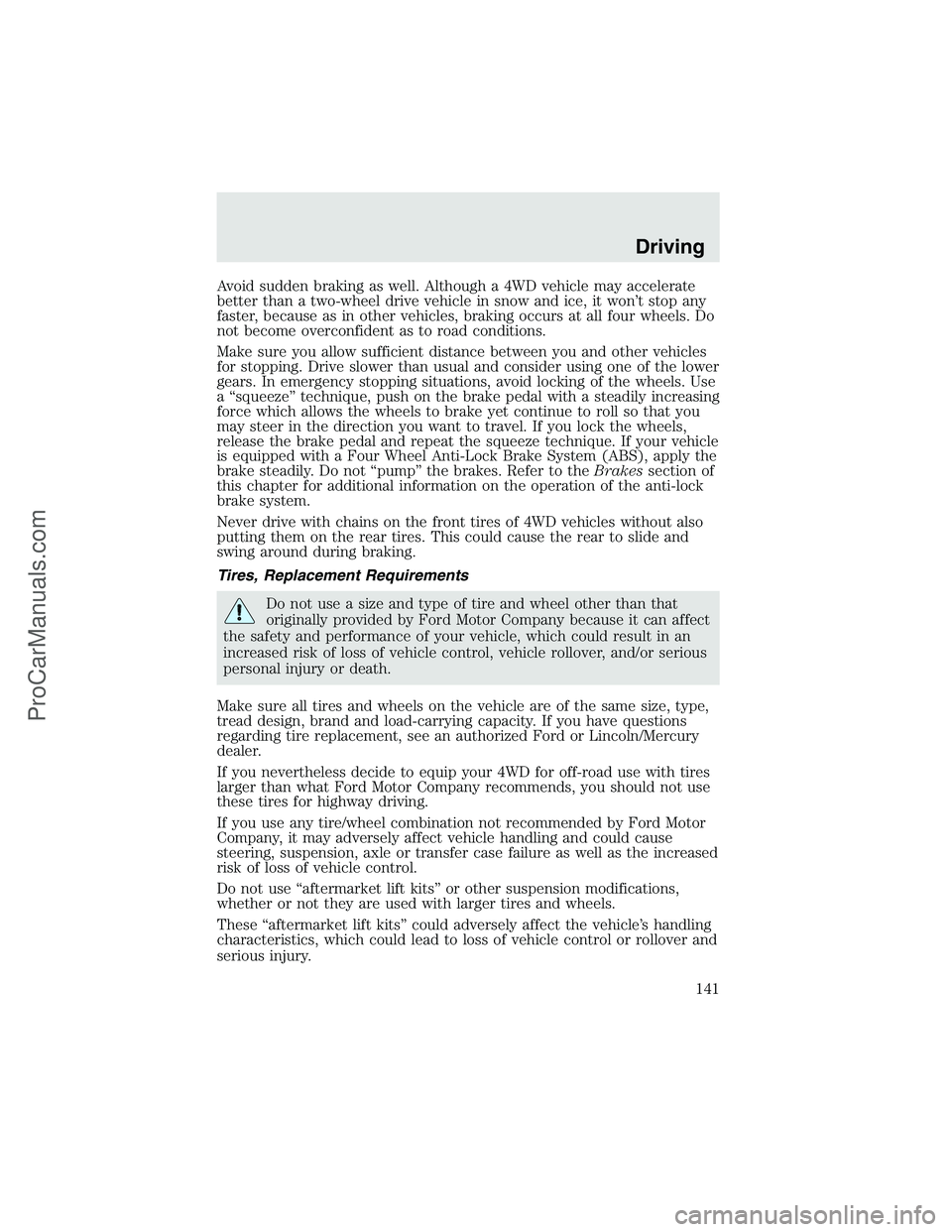2003 FORD F350 snow chains
[x] Cancel search: snow chainsPage 141 of 280

Avoid sudden braking as well. Although a 4WD vehicle may accelerate
better than a two-wheel drive vehicle in snow and ice, it won’t stop any
faster, because as in other vehicles, braking occurs at all four wheels. Do
not become overconfident as to road conditions.
Make sure you allow sufficient distance between you and other vehicles
for stopping. Drive slower than usual and consider using one of the lower
gears. In emergency stopping situations, avoid locking of the wheels. Use
a“squeeze”technique, push on the brake pedal with a steadily increasing
force which allows the wheels to brake yet continue to roll so that you
may steer in the direction you want to travel. If you lock the wheels,
release the brake pedal and repeat the squeeze technique. If your vehicle
is equipped with a Four Wheel Anti-Lock Brake System (ABS), apply the
brake steadily. Do not“pump”the brakes. Refer to theBrakessection of
this chapter for additional information on the operation of the anti-lock
brake system.
Never drive with chains on the front tires of 4WD vehicles without also
putting them on the rear tires. This could cause the rear to slide and
swing around during braking.
Tires, Replacement Requirements
Do not use a size and type of tire and wheel other than that
originally provided by Ford Motor Company because it can affect
the safety and performance of your vehicle, which could result in an
increased risk of loss of vehicle control, vehicle rollover, and/or serious
personal injury or death.
Make sure all tires and wheels on the vehicle are of the same size, type,
tread design, brand and load-carrying capacity. If you have questions
regarding tire replacement, see an authorized Ford or Lincoln/Mercury
dealer.
If you nevertheless decide to equip your 4WD for off-road use with tires
larger than what Ford Motor Company recommends, you should not use
these tires for highway driving.
If you use any tire/wheel combination not recommended by Ford Motor
Company, it may adversely affect vehicle handling and could cause
steering, suspension, axle or transfer case failure as well as the increased
risk of loss of vehicle control.
Do not use“aftermarket lift kits”or other suspension modifications,
whether or not they are used with larger tires and wheels.
These“aftermarket lift kits”could adversely affect the vehicle’s handling
characteristics, which could lead to loss of vehicle control or rollover and
serious injury.
Driving
141
ProCarManuals.com
Page 253 of 280

Make sure that all replacement tires are of the same size, type,
speed rating, load-carrying capacity and tread design (e.g.,“All
Terrain”,“Touring”, etc.), as originally offered by Ford.
Do not replace your tires with“high performance”tires or larger
size tires.
Failure to follow these precautions may adversely affect the
handling of the vehicle, and increase the risk of loss of vehicle
control, vehicle rollover and/or personal injury.
Tires that are larger or smaller than your vehicle’s original tires may also
affect the accuracy of your speedometer.
SNOW TIRES AND CHAINS
Snow tires must be the same size and grade as the tires you
currently have on your vehicle.
The tires on your vehicle have all weather treads to provide traction in
rain and snow. However, in some climates, you may need to use snow
tires and chains. If you need to use chains, it is recommended that steel
wheels (of the same size and specifications) be used, as chains may chip
aluminum wheels.
Follow these guidelines when using snow tires and chains:
•Use only SAE Class S chains.
•Install chains securely, verifying that the chains do not touch any
wiring, brake lines or fuel lines.
•Drive cautiously. If you hear the chains rub or bang against your
vehicle, stop and re-tighten the chains. If this does not work, remove
the chains to prevent damage to your vehicle.
•If possible, avoid fully loading your vehicle.
•Remove the tire chains when they are no longer needed. Do not use
tire chains on dry roads.
•The suspension insulation and bumpers will help prevent vehicle
damage. Do not remove these components from your vehicle when
using snow tires and chains.
Maintenance and Specifications
253
ProCarManuals.com
Page 279 of 280

Power distribution box
(see Fuses) ...............................178
Power door locks ..................65, 70
Power point .................................53
Power steering ..........................117
fluid, checking and adding ....240
fluid, refill capacity ................254
fluid, specifications .........258, 261
Power Windows ...........................53
Preparing to drive your
vehicle ........................................117
R
Radio ..........................20, 22, 25, 29
Relays ........................................177
Remote entry system .................67
illuminated entry ......................70
locking/unlocking doors ...........65
Reverse sensing system ...........126
Roadside assistance ..................175
S
Safety belts (see Safety
restraints) ........................77–81, 83
Safety defects, reporting ..........208
Safety restraints ....................77–83
belt minder ...............................85
cleaning the safety belts ..........89
extension assembly ..................89
for adults .............................78–81
for children ...............................99
lap belt ......................................84
warning light and chime ..........85
Safety seats for children ..........102
Seat belts (see Safety
restraints) ....................................77Seats ............................................72
child safety seats ....................102
cleaning ...................................213
Servicing your vehicle ..............216
Snowplowing .................8, 171–173
Spare tire
(see Changing the Tire) ...........182
Spark plugs,
specifications .....................254, 261
Special notice ................................9
ambulance conversions ..............8
diesel-powered vehicles .............8
four-wheel drive
vehicles ............................173–174
utility-type vehicles ....................8
Specification chart,
lubricants ...........................258, 261
Speed control ..............................57
Starting your
vehicle ........................110–111, 113
jump starting ..........................193
Steering wheel
tilting .........................................50
T
Tailgate ........................................64
Tires ...................................247–249
changing ..........................182, 185
checking the pressure ............249
replacing ..................................252
rotating ....................................250
snow tires and chains ............253
tire grades ...............................248
treadwear ................................248
Towing .......................................145
trailer towing ..........................145
wrecker ....................................198
Index
279
ProCarManuals.com